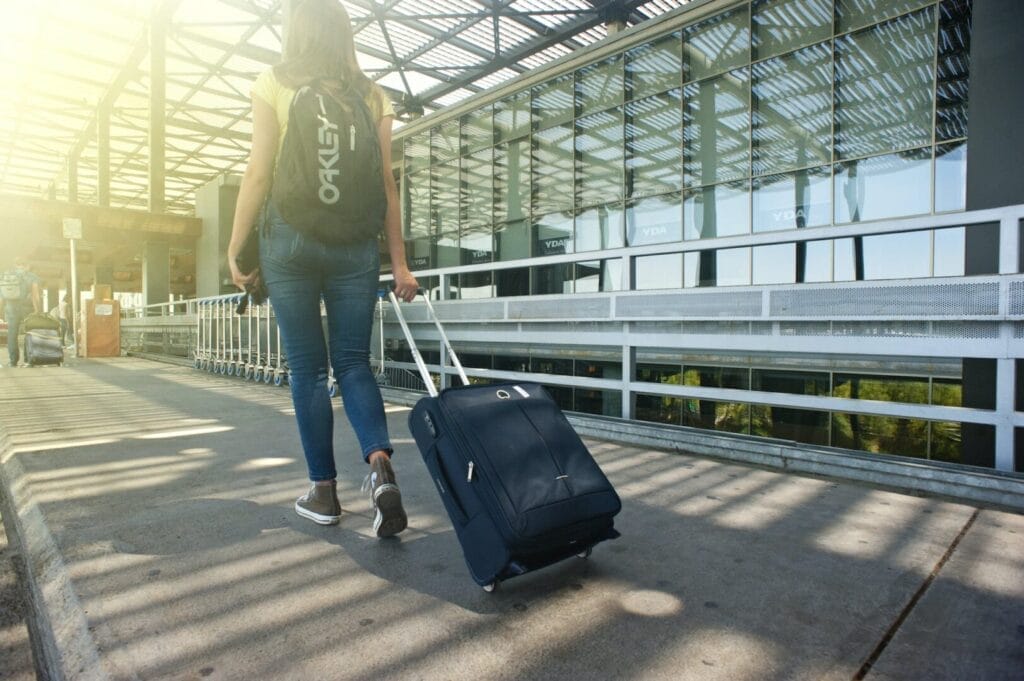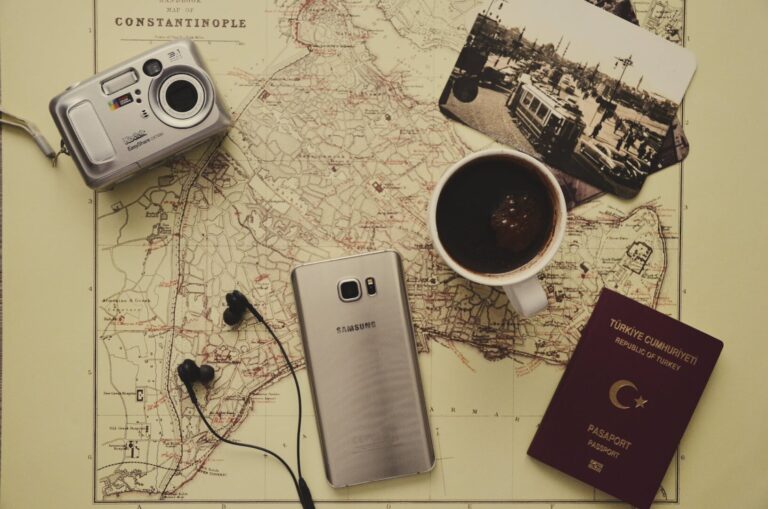How to Pack Light for Europe? Tips for Minimalist Packing
So you are planning ready for your European adventure but really worried about travelling with a heavy suitcase. I have been there.
The last thing you want is to pay for the excess baggage while exploring Historic cobblestone streets or hopping on and off trains if you are travelling with a train in Europe.
Packing light is the key to convenience, mobility, and avoiding those pesky excessive luggage fees. In this article, we will guide you through the art of packing light for your European getaway, ensuring you can focus on creating unforgettable memories without the burden of a heavy load.

Tip 1 – Research about Luggage Restriction and Weather Forecast.
Before you start your packing process you should be aware of the luggage restrictions of the airlines and train companies.
This knowledge will help you avoid unexpected fees or inconveniences at the airport or train station. Luggage restrictions may vary, so it’s crucial to double-check the specific guidelines for each carrier you’ll be using during your trip.
You have to be sure that you have not booked flights on cheap carriers in Europe because you will have to pay extra for your luggage unless you want to pack everything which can fit in your Ryan Air backpack 😉
While researching luggage restrictions, be sure to check weather forecasts for the destinations you’ll be visiting. Understanding the expected weather conditions will enable you to pack appropriate clothing and avoid overpacking unnecessary items. Remember, the key is to strike a balance between being prepared for the weather without bringing your entire wardrobe.
Create a packing checklist to stay organized. Jot down the essentials, such as clothing items, toiletries, travel documents, and electronics, to ensure you don’t miss anything important while packing.
If you are lazy to do so then we have the Packing List for Europe which you can download and use or you can use our Wanderlust Planner to plan your entire trip from packing to finances.
Tip 2 – Choose Versatile Clothing Items
When it comes to packing clothing, versatility is your best friend. Select clothing items that can be easily mixed and matched to create various outfits. Opt for neutral-coloured tops and bottoms that can be combined in different ways, allowing you to create a new look each day without overpacking.
Consider packing convertible pants that can be transformed into shorts or capris, providing you with more options in a single garment. Lightweight layers, such as cardigans or scarves, are also excellent choices as they can be used to layer up during chilly evenings or dress up an outfit for a nice dinner.
Choose clothing made from materials like Merino wool or synthetic blends. These fabrics are lightweight, dry quickly, and resist odour, allowing you to re-wear certain items throughout your trip. Not only will this help you save space and reduce laundry needs, but it will also prevent your suitcase from smelling like a dirty laundry pile.
Bring layers. The weather in Europe can change quickly, so it’s important to bring layers. This will allow you to adjust to the temperature without having to carry a lot of clothes.
One thing which I always carry in Europe is a light weight Rain jacket because trust me it can rain anywhere anytime in Europe.
Tip 3 – Utilize Space-Saving Packing Techniques
Maximize space in your luggage by utilizing space-saving packing techniques. Packing cubes, compression bags, or roll-up packing methods are excellent tools to help you organize your belongings and save space.
You can use Packing cubes which are small, lightweight zippered bags that allow you to separate different categories of clothing items. Divide your clothes into cubes based on type or outfit, making it easier to find what you need without unpacking your entire suitcase. Compression bags are especially handy for squeezing the air out of bulky items like jackets or sweaters, reducing their size and maximizing space.
Rolling your clothes, rather than folding them, is another effective technique for saving space. This method helps prevent wrinkles and frees up space for other items. Take it a step further by packing smaller items like socks or underwear within the small crevices of rolled clothing to utilize every inch of space efficiently.
Tip 4 – Essential Items Checklist
Creating a curated checklist of essential items will ensure you don’t leave anything vital behind. Here are some items you shouldn’t forget to pack:
- ravel documents: Passports, IDs, visas, travel insurance, and copies of all important documents.
- Portable charger: Keep your devices charged and ready to capture those picture-perfect moments.
- Travel adapter: Research the appropriate adapter for your destination to keep your electronics powered up.
- Essential medication: Pack any necessary prescription medications and consider carrying a copy of your prescription, just in case.
When packing, think in terms of multi-functionality. A lightweight scarf can double as a cover-up, a headscarf, or an accessory to change up your outfit. A microfiber towel can be used for picnics, as a travel blanket, or even for spontaneous beach visits. By selecting items with multiple uses, you can reduce the number of things you need to pack.
Remember, it’s essential to leave unnecessary items behind. Bulky guidebooks may weigh you down while exploring, and excessive electronics can become a burden. Consider utilizing smartphone apps for navigation and local information, eliminating the need for additional gadgets and guidebooks.
Tip 5: Leave unnecessary items at home.
There are many items that you don’t need to bring with you on your trip to Europe. This is because Europe has a well-developed infrastructure, and you can easily find most of the things you need there. For example, you can buy toiletries at any pharmacy or grocery store. And if you need to wash your clothes, you can use the hotel laundry service or a laundromat.
Here are some specific items that you can leave at home:
- Toiletries: Shampoo, conditioner, body wash, toothpaste, toothbrush, deodorant, sunscreen, insect repellent, etc.
- Laundry supplies: Detergent, fabric softener, dryer sheets, etc.
- Hair styling tools: Hairdryer, curling iron, flat iron, etc.
- Excess clothing: You don’t need to bring a lot of clothes with you to Europe. You can pack a few versatile pieces and mix and match them to create different outfits.
- Heavy shoes: You’ll be doing a lot of walking in Europe, so it’s important to pack comfortable shoes. However, you don’t need to bring your heaviest shoes. A pair of sneakers or walking shoes will be sufficient.
- Expensive jewellery: It’s not a good idea to wear expensive jewellery when travelling, especially in crowded areas. You can leave your expensive jewellery at home and wear less expensive pieces while travelling.
- Electronics that you don’t need: You don’t need to bring every electronic device you own with you to Europe. For example, if you’re not going to be doing a lot of work on your trip, you can leave your laptop at home.
By leaving these items at home, you can pack lighter and have more room in your suitcase for souvenirs. You’ll also save money on baggage fees.
Tips for Managing Laundry On-The-Go
Managing laundry while travelling is a necessary task that doesn’t have to be a hassle. Here are some tips to help you stay on top of your laundry needs:
- Pack a small laundry kit: A portable laundry detergent and stain remover can be a lifesaver. Look for travel-sized options or transfer small amounts into reusable travel containers.
- Utilize hotel laundry services: If you’re staying at hotels during your trip, take advantage of their laundry services. This option can be a time and space saver, allowing you to pack less clothing.
- Wash and hang dry: Packing a small clothesline or even using a piece of paracord can be useful for washing and hanging small items in your accommodations. Remember to pack a travel-sized, quick-drying detergent for easy handwashing.
Packing one or two pairs of quick-drying and lightweight underwear can greatly reduce the need for excessive clothing. These easily washable garments will dry overnight, allowing you to reuse them throughout your trip.
Summary: How to Pack Light for Europe
Packing light for Europe is possible and beneficial. By following the tips in this post, you can pack everything you need for your trip without weighing yourself down. This will allow you to enjoy your trip more and save money on baggage fees.
Here are a few key takeaways:
- Choose the right luggage. A carry-on suitcase or backpack is ideal for most trips to Europe.
- Roll your clothes instead of folding them. This will save space in your suitcase.
- Bring versatile clothes. Choose clothes that can be mixed and matched to create different outfits.
- Bring layers. The weather in Europe can change quickly, so it’s important to bring layers.
- Leave unnecessary items at home. There are many items that you don’t need to bring with you on your trip to Europe, such as toiletries and laundry supplies.
By following these tips, you can pack light for Europe and have a more enjoyable trip.
I hope this post has been helpful!
FAQ – For Minimalist Packing for Europe
What is the best type of luggage to bring for a trip to Europe?
A carry-on suitcase or backpack is ideal for most trips to Europe. This will allow you to avoid baggage fees and save time at the airport. If you are planning on bringing a lot of souvenirs, you may want to consider bringing a checked bag as well.
What clothes should I pack for a trip to Europe?
When packing clothes for a trip to Europe, it is important to choose versatile pieces that can be mixed and matched to create different outfits. You should also bring layers, as the weather can change quickly.
What should I do if I need to wash my clothes while I’m in Europe?
Most hotels offer laundry service, so you can wash your clothes there. You can also find laundromats in most major cities.


